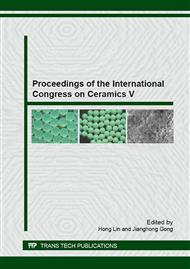[1]
C. Ramirez, L. Garzón and P. Miranzo et al. Electrical Conductivity Maps in Graphene Nanoplatelet/silicon Nitride Composites Using Conducting Scanning Force Microscopy. Carbon, 49(2011)3873-3880.
DOI: 10.1016/j.carbon.2011.05.025
Google Scholar
[2]
M. Zhou, H. Bi and X. J. Lu et al. Heat Transport Enhancement of Thermal Energy Storage Material Using Graphene/ceramic composites. Carbon (2014), doi: http: /dx. doi. org /10. 1016/ j. carbon.
DOI: 10.1016/j.carbon.2014.04.009
Google Scholar
[3]
P. Hvizdoš, J. Dusza and C. Balázsi. Tribological Properties of Si3N4-graphene Nanocomposites. Journal of European Ceramic Society, 33(2013)2359-2364.
DOI: 10.1016/j.jeurceramsoc.2013.03.035
Google Scholar
[4]
L. S. Walker, V. R. Marotto and M. A. Rafiee et al. Toughening in Graphene Ceramic Composites. ACS Nano, 4(2011)3182-3190.
DOI: 10.1021/nn200319d
Google Scholar
[5]
Y. P. Wu, Y. F. Hao and H. Y. Jeong et al. Crystal Structure Evolution of Individual Graphene Islands During CVD Growth on Copper Foil. Advanced Materials, 25(2013)6744-6751.
DOI: 10.1002/adma.201302208
Google Scholar
[6]
Z. P. Chen, W. C. Ren and B. Liu. Bulk Growth of Mono- to Few-Layer Graphene on Nickel Particles by Chemical Vapor Deposition from Methane. Carbon, 48(2010)3543-3550.
DOI: 10.1016/j.carbon.2010.05.052
Google Scholar
[7]
Z. P. Xu and M. J. Buehler. Interface Structure and Mechanics between Graphene and Metal Substrates: a First-Principles Study. J. Phys.: Condens. Matter, 22(2010)485301.
DOI: 10.1088/0953-8984/22/48/485301
Google Scholar
[8]
L. Adamska, Y. Lin and A. J. Ross et al. Atomic and Electronic Structure of Simple Metal/Graphene and Complex Metal/Graphene/Metal Interfaces. Physical Review B, 85(2012)195443.
DOI: 10.1103/physrevb.85.195443
Google Scholar
[9]
C. Gong, G. Lee and B. Shan et al. First-Principles Study of Metal-Graphene Interface. J. Appl. Phys, 108(2010)123711.
Google Scholar
[10]
C. Gong, D. Hinojos and W. C. Wang et al. Metal-Graphene-Metal Sandwich Contacts for Enhanced Interface Bonding and Work Function Control. ACS Nano, 6(2012)5381-5387.
DOI: 10.1021/nn301241p
Google Scholar
[11]
Z. M. Ao, W. T. Zheng and Q. Jiang. The Effects of Electronic Field on the Atomic Structure of the Graphene/α-SiO2 Interface. Nanotechnology, 19(2008)275710.
DOI: 10.1088/0957-4484/19/27/275710
Google Scholar
[12]
X. H. Zhang, X. G. Luo and J. P. Li et al. Structure and Bonding Features of ZrB2(0001) Surface. Computational Materials Science, 46(2009)1-6.
Google Scholar
[13]
P. L. Liu, A. V. G. Chizmeshya and J. Kouvetakis. Structural, Electronic, and Energetic Properties of SiC.
Google Scholar
[1]
heterojunctions: A First-Principles Density Functional Theory Study. Physical Review B, 77(2008)035326.
Google Scholar
[14]
G. B. Yadhukulakrishnan, S. Karumuri and A. Rahman et al. Spark Plasma Sintering of Graphene Reinforced Zirconium diboride Ultra High Temperature Ceramic Composites. Ceramics International, 39(2013)6637-6646.
DOI: 10.1016/j.ceramint.2013.01.101
Google Scholar
[15]
H. K. Clark and J. L. Hoard. The Crystal Structure of Boron Carbide. J. Amer. Chem. Soc, 65(1943)2115-2119.
DOI: 10.1021/ja01251a026
Google Scholar
[16]
A. N. Christensen. A Neutron Diffraction Investigation on Single Crystals of Titanium Oxide, Zirconium Carbide and Hafnium Nitride Christensen. Acta Chemica Scandinavica, 44(1990)851-852.
DOI: 10.3891/acta.chem.scand.44-0851
Google Scholar


